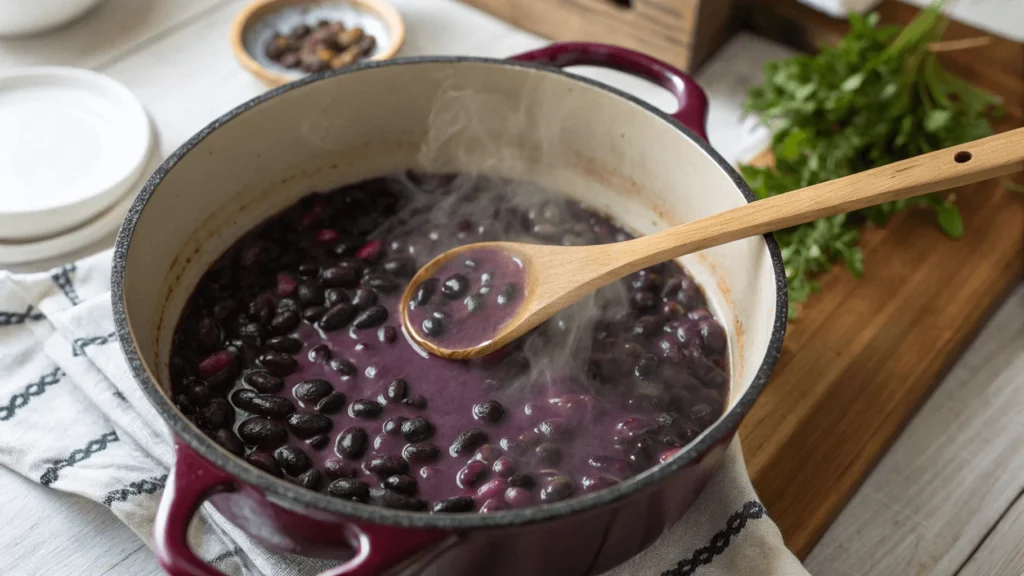Black beans are a staple in many cuisines worldwide, celebrated for their rich flavor, versatility, and impressive nutritional profile. But if you’ve ever cooked or soaked black beans, you might have noticed something curious: they often turn the water purple, or the beans themselves may take on a purplish hue. Why do black beans turn purple? This color transformation isn’t just a quirky kitchen phenomenon—it’s rooted in science.
The key to understanding “Why Do Black Beans Turn Purple” lies in their natural pigments and how they react under different conditions, such as soaking, cooking, or changes in pH. Beyond their visual appeal, these pigments contribute to the beans’ nutritional value and even play a role in cultural traditions. In this article, we’ll dive deep into the science behind black beans’ color changes, their health benefits, and tips for cooking them without losing their vibrant hues. By the end, you’ll have a newfound appreciation for this humble yet fascinating legume.
The Science Behind Black Beans’ Color
What Makes Black Beans Black?

The dark, glossy color of black beans comes from natural pigments called anthocyanins. These are the same compounds that give blueberries, blackberries, and red cabbage their vibrant hues. Why do black beans turn purple? When cooked or exposed to acidic conditions, the anthocyanins can change color, leading to a purplish hue. Anthocyanins are water-soluble pigments found in the outer coating of black beans, and their role extends beyond aesthetics—they help protect the plant from environmental stressors like UV radiation and pests.
Interestingly, the black color of the beans is not purely black. When viewed up close or under certain lighting, you may notice shades of deep purple or even dark blue. This similarity with other pigmented foods is fascinating, as discussed in comparisons with other natural dyes, where foods share similar pH-sensitive characteristics.
The Role of pH in Color Changes
One of the most fascinating properties of anthocyanins is their sensitivity to pH. When the pH of the surrounding environment changes—such as when black beans are soaked or cooked—the pigments can shift in color. Why do black beans turn purple? In acidic environments (low pH), anthocyanins tend to appear reddish, while in alkaline environments (high pH), they can take on a greenish-blue hue. Neutral conditions often result in the purplish tint commonly associated with black beans during cooking.
This explains why black beans may turn purple when soaked in water or cooked in certain types of cookware. Why do black beans turn purple? The water’s pH, combined with the heat and breakdown of the bean’s outer layer, allows the anthocyanins to diffuse and display their vibrant colors.
For further insights into maintaining ingredient quality, you can learn about balancing pH in cooking, a critical factor in retaining natural colors and flavors.
The Cooking Process and Color Transformation
What Happens When You Soak Black Beans?
Soaking black beans is a common practice to reduce cooking time and improve digestibility. Why do black beans turn purple? During this process, you may notice that the water turns a deep purple or even dark blue. This happens because the anthocyanins in the bean’s outer shell begin to dissolve in the water. The longer the beans soak, the more pigment is released.
The temperature of the water also plays a role. Warm or hot water tends to speed up the release of pigments, while cold water slows it down. Additionally, the minerals in the water, such as calcium or magnesium, can influence the intensity of the color change. Why do black beans turn purple? This color change occurs due to the presence of anthocyanins, which are pigments that react to changes in pH and temperature, resulting in a vibrant purple hue when exposed to certain conditions.
If you’re curious about culinary traditions that rely on soaking or brining methods, you can learn more about how traditional techniques enhance flavors.
Why Do Black Beans Turn Purple When Cooked?

Why Do Black Beans Turn Purple? Cooking black beans involves heat, which breaks down the cell walls of the beans and releases more anthocyanins into the cooking water. This is why the liquid in the pot often turns a rich purple or black color. The heat also interacts with the pH of the water, amplifying the color transformation.
Interestingly, the color change is more noticeable when beans are cooked in neutral or slightly acidic water. If you add an alkaline ingredient, like baking soda, the beans may lose their purple hue and take on a bluish-green tint instead. Why do black beans turn purple? This color change occurs due to the presence of anthocyanins, which are pigments that react to pH levels. This is a clear example of how pH and heat work together to influence the appearance of black beans during cooking.
Nutritional Benefits of Black Beans and Their Pigments
Health Benefits of Anthocyanins
The anthocyanins responsible for the purple hue of black beans aren’t just pretty—they’re packed with health benefits. Why do black beans turn purple? This color change is due to the presence of these pigments, which are powerful antioxidants that help combat oxidative stress in the body, reducing the risk of chronic diseases like heart disease, diabetes, and certain cancers. They also have anti-inflammatory properties, which can promote overall health and well-being.
Studies have shown that anthocyanins may improve brain function, support eye health, and even help regulate blood sugar levels. Why do black beans turn purple? This color change occurs due to the presence of these powerful antioxidants, which leach into the cooking water. So, the next time you see that purple water after cooking black beans, remember that it’s a sign of the beans’ nutritional power.
Other Nutrients in Black Beans
Beyond anthocyanins, black beans are a nutritional powerhouse. They’re an excellent source of plant-based protein, making them a staple for vegetarians and vegans. They’re also rich in dietary fiber, which supports healthy digestion and helps lower cholesterol levels. Why do black beans turn purple? This color change occurs due to the presence of anthocyanins, which are water-soluble pigments that can react to changes in pH, often becoming more pronounced when cooked or combined with acidic ingredients.
Black beans are packed with essential vitamins and minerals, including folate, magnesium, and potassium. Cooking methods can influence the retention of these nutrients, so it’s important to avoid overcooking or using excessive amounts of water, which can leach out some of the vitamins and minerals. Why do black beans turn purple? This color change occurs due to the presence of anthocyanins, a type of antioxidant that can react with acids during cooking, leading to a vibrant purple hue.
Cultural and Culinary Significance of Black Beans
Black Beans in Global Cuisine

Black beans play a vital role in many global cuisines, adding flavor and depth to a variety of dishes. Latin American cooking highlights them in classics like Cuban black bean soup, Brazilian feijoada, and Mexican refried beans. The Caribbean pairs black beans with rice to create hearty and satisfying meals that are both nutritious and flavorful. But why do black beans turn purple? This color change occurs when black beans are cooked or exposed to acidic ingredients, as the pigments in the beans react to heat and pH levels, creating a vibrant purple hue that adds visual appeal to dishes.
Asian cuisine uses black beans in unique ways, often fermenting them to create sauces and pastes that enhance the umami flavor of traditional dishes. The purple tint that sometimes appears during cooking enhances the natural beauty of the beans, making them visually appealing in recipes. This color change occurs due to the presence of anthocyanins, which are pigments that can react with acidic ingredients or certain cooking methods, resulting in a vibrant purple hue.
Symbolism and Traditions
Many cultures view black beans as more than just food—they assign symbolic meanings to them. For example, Mexican celebrations often include black beans in meals to represent abundance and unity. Communities worldwide associate their rich, dark color and nutritional value with resilience and strength. Additionally, many people wonder why black beans turn purple when cooked. This color change is due to the presence of anthocyanins, a type of antioxidant that reacts to heat and changes in pH, adding to the beans’ appeal and nutritional benefits.
Throughout history, people have relied on black beans as a source of sustenance, using them to provide energy and nourishment. Their versatility in cooking reflects their cultural importance, as traditional recipes often highlight their natural flavors and textures.
Tips for Cooking Black Beans Without Losing Their Color
How to Preserve the Black Color While Cooking
If you want to keep your black beans looking their best, there are a few tricks to follow. First, avoid cooking them in alkaline water, as this can cause the beans to lose their dark color and turn greenish. Instead, use slightly acidic water by adding a splash of vinegar or lemon juice. Why do black beans turn purple? This color change can occur due to various factors, including the pH level of the cooking water and the presence of certain minerals, which can alter the anthocyanins in the beans, leading to a purplish hue.
Cooking black beans with the lid on can also help retain their color by trapping steam and preventing excessive oxidation. Why do black beans turn purple? This color change can occur due to the presence of anthocyanins, which are pigments that react to changes in pH and temperature. Additionally, avoid overcooking the beans, as prolonged heat can break down the pigments and cause them to fade.
Common Mistakes to Avoid
One common mistake is using hard water, which contains high levels of minerals that can dull the beans’ color. To fix this, consider using filtered or distilled water. Another mistake is soaking the beans for too long, which can cause excessive pigment loss. Aim for a soaking time of 6–8 hours for optimal results. So, why do black beans turn purple? This color change can occur due to the presence of anthocyanins, which are natural pigments that react to changes in pH levels and can be influenced by the water used during cooking.
By following these tips, you can enjoy beautifully colored black beans that retain their vibrant hues and nutritional benefits. Why do black beans turn purple? This color change can occur due to various factors, including cooking methods, acidity, and the presence of certain minerals. Understanding these aspects can help you maintain their appealing color while maximizing their health benefits.
Fun Facts About Black Beans and Their Pigments
Unique Properties of Black Beans
Black beans are one of the most versatile legumes, with a unique ability to retain their shape and texture even after long cooking times. Their anthocyanins not only give them their striking color but also act as natural preservatives, helping the beans resist spoilage. So, why do black beans turn purple? The color change can occur due to various factors, including the cooking process and the pH of the environment, which can affect the stability of the anthocyanins.
Comparisons with Other Pigmented Foods
Black beans share their anthocyanin pigments with other colorful foods like red cabbage, eggplants, and black rice. Why do black beans turn purple? Interestingly, the same pH-sensitive properties that cause black beans to turn purple can also be observed in these foods. For example, red cabbage juice can change colors depending on whether it’s exposed to an acidic or alkaline environment, just like black beans.
FAQs About Black Beans Turning Purple
Why Do Black Beans Change Color When Cooked?
When cooked, black beans release anthocyanins, which react to heat and pH changes in the water. This causes the beans and the cooking liquid to take on a purple or even bluish hue. The color change is a natural result of the pigments breaking down and diffusing into the water.
Are Purple Black Beans Healthier Than Regular Black Beans?
The purple tint in black beans is a sign of their anthocyanin content, which provides antioxidant and anti-inflammatory benefits. While the nutritional value of black beans remains consistent regardless of color changes, the presence of these pigments adds an extra layer of health benefits.
How Can You Tell If Black Beans Have Gone Bad?
Spoiled black beans often have a sour or off-putting smell, a slimy texture, or visible mold. A color change to purple during soaking or cooking is normal and should not be confused with spoilage. Always store black beans in a cool, dry place and cook them properly to ensure they’re safe to eat.
Does Soaking Black Beans Affect Their Flavor or Texture?
Soaking black beans softens their texture and reduces cooking time, but it doesn’t significantly alter their flavor. The purple water that results from soaking is simply the release of pigments and does not impact the beans’ taste. Proper soaking can also help reduce compounds that cause digestive discomfort.
Why Does the Water Turn Purple When Soaking Black Beans?
When black beans are soaked, their outer layer releases anthocyanins into the water. These water-soluble pigments naturally seep out during soaking, especially if the water is warm or contains certain minerals. The purple tint in the water is a direct result of this process, and it’s completely normal.
Are Black Beans Still Safe to Eat After Turning Purple?
Absolutely! Black beans remain entirely safe to eat even after turning purple. The color change occurs due to the anthocyanins reacting to heat or pH changes, and it doesn’t affect the beans’ flavor or nutritional value. In fact, the purple hue is an indicator of their rich antioxidant content, which offers numerous health benefits.
Can You Prevent Black Beans from Turning Purple?
It’s not easy to completely prevent black beans from turning purple, but you can reduce the effect by cooking them in slightly acidic water. Adding a small amount of vinegar or lemon juice helps stabilize the anthocyanins, keeping the beans darker. Why do black beans turn purple? The purple tint is due to the presence of anthocyanins, which are natural pigments that can change color depending on the pH of their environment. However, this purple tint is a natural and harmless occurrence, so there’s no real need to avoid it.
Conclusion and Final Thoughts
Recap of Key Points
Black beans’ transformation from black to purple is a fascinating process rooted in science. Why do black beans turn purple? The anthocyanins in their outer layer are responsible for their dark color and play a key role in the vibrant purple hue that emerges during soaking or cooking. These pigments not only add visual appeal but also provide significant health benefits, from antioxidant properties to anti-inflammatory effects.
Encouragement to Experiment with Black Beans
Rather than seeing the purple tint as a mystery, embrace it as part of the natural beauty of black beans. Why do black beans turn purple? This color change occurs due to anthocyanins, which are natural pigments that can react with different pH levels in cooking. Whether you’re making soups, stews, or salads, let the color change inspire you to experiment with new recipes. The next time you see that purple water or notice a slight color shift, you’ll know it’s a sign of the beans’ rich nutritional content and their connection to the science of food.

